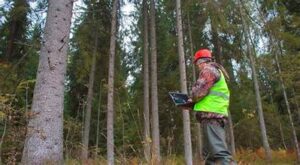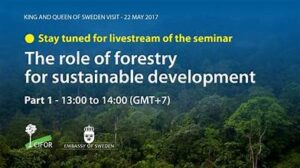
Forestry is at a critical juncture as we navigate the environmental challenges of the 21st century. As we approach 2024, the need for sustainable forestry practices has never been more pressing. Innovative approaches are transforming the field, ensuring that forestry not only meets current economic demands but also preserves the environment for future generations. This article explores the groundbreaking techniques that are shaping sustainable forestry today.
The Importance of Sustainable Forestry
Sustainable forestry is essential for maintaining the health of our forests and the ecosystems they support. It involves managing forest resources in a way that meets current needs without compromising the ability of future generations to meet theirs. This includes maintaining biodiversity, preventing deforestation, and managing forest resources responsibly.
Forests are vital for carbon sequestration, which helps mitigate climate change. They also provide habitat for wildlife, support water cycles, and contribute to soil conservation. As human activity continues to impact these critical resources, innovative approaches are necessary to balance environmental protection with economic interests.
Cutting-Edge Technologies in Sustainable Forestry
1. Remote Sensing and GIS Technology
Remote sensing and Geographic Information Systems (GIS) are revolutionizing forest management. These technologies allow for precise monitoring of forest conditions, including tree health, forest cover changes, and illegal logging activities. By using satellite imagery and aerial drones, forestry professionals can gather real-time data, which enhances decision-making and management practices.
Applications:
- Forest Inventory: Accurate and efficient mapping of tree species, age, and density.
- Deforestation Tracking: Monitoring and responding to illegal logging activities.
- Health Assessments: Identifying pest infestations and diseases before they spread.
2. Drones for Forest Management
Drones have become invaluable tools in modern forestry. They provide high-resolution images and data that are essential for managing large forest areas. Drones can be used for various purposes, including mapping, monitoring, and surveying.
Benefits:
- Enhanced Data Collection: Detailed and accurate information on forest conditions.
- Cost-Effective Monitoring: Reduces the need for ground-based surveys.
- Rapid Response: Quick assessment of damage from natural disasters or pests.
3. Precision Forestry
Precision forestry involves the use of advanced technologies to optimize forest management practices. This approach uses data from various sources, including remote sensing, GPS, and IoT (Internet of Things) sensors, to make informed decisions about forest operations.
Techniques:
- Variable Rate Application: Adjusting the amount of inputs like fertilizers and pesticides based on specific needs.
- Automated Harvesting: Using machinery equipped with sensors to minimize waste and damage.
- Site-Specific Management: Tailoring practices to the unique conditions of different forest areas.
Sustainable Harvesting Techniques
1. Selective Logging
Selective logging is a method where only certain trees are harvested based on specific criteria, such as age, species, or health. This technique minimizes ecological impact by leaving the majority of the forest intact, promoting natural regeneration and preserving biodiversity.
Advantages:
- Reduced Soil Disturbance: Less disruption to the forest floor.
- Biodiversity Preservation: Maintains habitat for wildlife.
- Forest Regeneration: Encourages natural regrowth of native species.
2. Continuous Cover Forestry
Continuous cover forestry (CCF) involves maintaining a permanent forest cover through various methods, such as selective logging, shelterwood systems, and agroforestry. This approach ensures that the forest remains intact and continues to provide ecological benefits.
Methods:
- Shelterwood Systems: Gradual removal of trees to allow natural regeneration.
- Agroforestry: Integrating trees with agricultural crops to create a sustainable land-use system.
Community Involvement and Indigenous Knowledge
1. Engaging Local Communities
Involving local communities in forestry management is crucial for the success of sustainable practices. Community-based forest management ensures that local knowledge and needs are considered, leading to more effective and culturally appropriate solutions.
Benefits:
- Improved Management: Local expertise can enhance decision-making.
- Economic Opportunities: Provides livelihoods and supports local economies.
- Cultural Preservation: Respects and incorporates traditional practices.
2. Integrating Indigenous Knowledge
Indigenous communities have long practiced sustainable forestry techniques that align with the principles of ecological balance. Integrating this traditional knowledge with modern practices can lead to more holistic and effective forest management.
Examples:
- Traditional Fire Management: Using controlled burns to reduce wildfire risk.
- Permaculture Techniques: Designing agricultural systems that mimic natural ecosystems.
Policy and Regulation Innovations
1. Adaptive Management Frameworks
Adaptive management is an approach that involves continuous learning and adjustment based on new information and changing conditions. This framework is essential for responding to the dynamic nature of forests and the challenges posed by climate change.
Key Aspects:
- Monitoring and Evaluation: Regular assessment of management practices and outcomes.
- Flexibility: Adjusting strategies based on new data and feedback.
- Collaboration: Working with stakeholders to implement adaptive strategies.
2. Certification Programs
Certification programs, such as those provided by the Forest Stewardship Council (FSC) and the Program for the Endorsement of Forest Certification (PEFC), ensure that forestry practices meet high environmental and social standards. These certifications promote responsible management and provide consumers with confidence in the sustainability of forest products.
Benefits:
- Market Access: Provides access to markets that demand certified products.
- Environmental Protection: Encourages adherence to sustainable practices.
- Consumer Trust: Builds confidence in the sustainability of forest products.
The Future of Sustainable Forestry
As we move into 2024 and beyond, the focus on sustainable forestry will continue to grow. The integration of innovative technologies, community involvement, and adaptive management practices will play a critical role in shaping the future of forestry. By embracing these approaches, we can ensure that our forests remain healthy, productive, and resilient for generations to come.
In conclusion, sustainable forestry is not just about preserving forests but also about innovating to create a balance between environmental stewardship and economic development. The techniques and practices discussed in this article are paving the way for a more sustainable and responsible approach to managing our forest resources. As these innovations continue to evolve, they offer hope for a future where our forests thrive alongside human progress.


